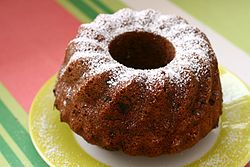Bundt cake
A Bundt cake (pronunciation: /b?nt/) is a cake that is baked in a Bundt pan, shaping it into a distinctive ridged ring. The shape is inspired by a traditional European fruit cake known as Gugelhupf, but Bundt cakes are not generally associated with any single recipe. . The style of mold in North America was popularised in the 1950s and 60s, after cookware manufacturer H. David Dalquist trademarked the name "Bundt" and began producing Bundt pans from cast aluminum. Publicity from Pillsbury saw the cakes gain widespread popularity.The Bundt cake derives in part from a European brioche-like fruit cake called Gugelhupf which was popular among Jewish communities in parts of Germany, Austria and Poland.[1] In the north of Germany Gugelhupf is traditionally known as Bundkuchen (German pronunciation: [?b?ntku?xn]), a name formed by joining the two words Kuchen (cake) and Bund.[2] Opinions differ as to the significance of the word Bund. One possibility is that it means "bunch" or "bundle", and refers to the way the dough is bundled around the tubed center of the pan.[2] Another source suggests that it describes the banded appearance given to the cake by the fluted sides of the pan, similar to a tied sheaf or bundle of wheat.[3] Some authors have suggested that Bund instead refers to a group of people, and that Bundkuchen is so called because of its suitability for parties and gatherings.[4][5] Uses of the word "bund" to describe cakes outside of Europe can be found in Jewish-American cookbooks from around the start of the 20th century.[6][7] The alternative spelling "bundt" also appears in a recipe as early as 1901.Bundt cakes do not conform to any single recipe; instead their characterizing feature is their shape. A Bundt pan has distinctive fluted or grooved sides, and a central tube or "chimney" which leaves a cylindrical hole through the center of the cake. The design means that more of the mixture touches the surface of the pan than in a simple round pan, helping to provide faster and more even heat distribution during cooking.[2][9] The shape is similar to that of the earlier European Gugelhupf or Bu

dkuchen. A Gugelhupf differs from contemporary Bundt-style cakes in that it follows a particular yeast-based recipe, with fruit and nuts, and is often deeper in shape and more decorative.[1] Also similar in shape is the Eastern European Babka, dating from early 18th century Poland.[10] While Bundt cake is associated with Jewish culture, Babka is firmly set in Christian tradition and is traditionally baked for Christmas and Easter. Since the name "Bundt" is a trademark, similar pans are often sold as "fluted tube pans" or given other similar descriptive titles.[9] The trademark holder Nordic Ware only produces Bundt pans in aluminum, but similar fluted pans are available in other materials.[citation needed] [edit]Rise to popularity Rainbow Bundt cake, partially sliced The person credited with popularizing the Bundt cake is American businessman H. David Dalquist, who co-founded cookware company Nordic Ware based in St. Louis Park, Minnesota. In around 1950, a group of Jewish-American Hadassah Society members approached Dalquist asking if he could produce a modern version of a traditional ceramic Gugelhupf dish.[2] Nordic Ware made a small number of the pans, using cast aluminum, and trademarked them under the name "Bundt".[5] A number of the original Bundt pans now reside in the Smithsonian collection.[11] Initially, the Bundt pan sold so poorly that Nordic Ware considered discontinuing it.[11] The product received a boost when it was mentioned in the New Good Housekeeping Cookbook in 1963,[12][13] but did not gain real popularity until 1966 when a Bundt cake called the "Tunnel of Fudge" took second place at the annual Pillsbury Bake-Off.[12] The resulting scramble caused the Bundt pan to surpass the tin Jell-O mold to become the most-sold pan in the United States.[citation needed] In the 1970s Pillsbury licensed the name Bundt from Nordic Ware and for a while sold a range of Bundt cake mixes.[5] To date more than 60 million Bundt pans have been sold by Nordic Ware across North America.[14] To mark the 60th anniversary of the pan the company designated November 15 as "National Bundt Day".